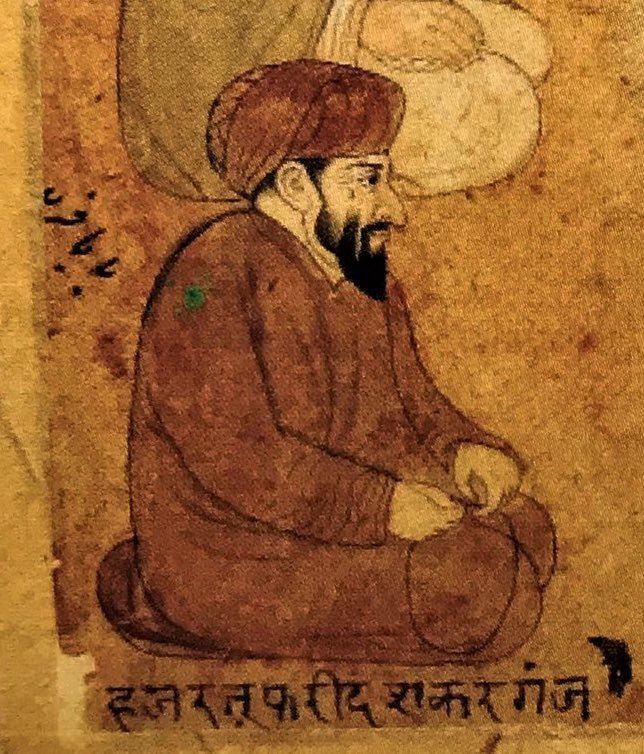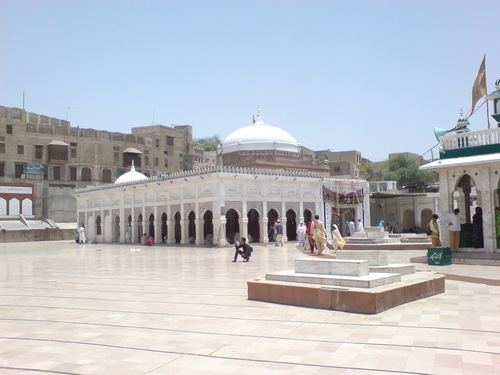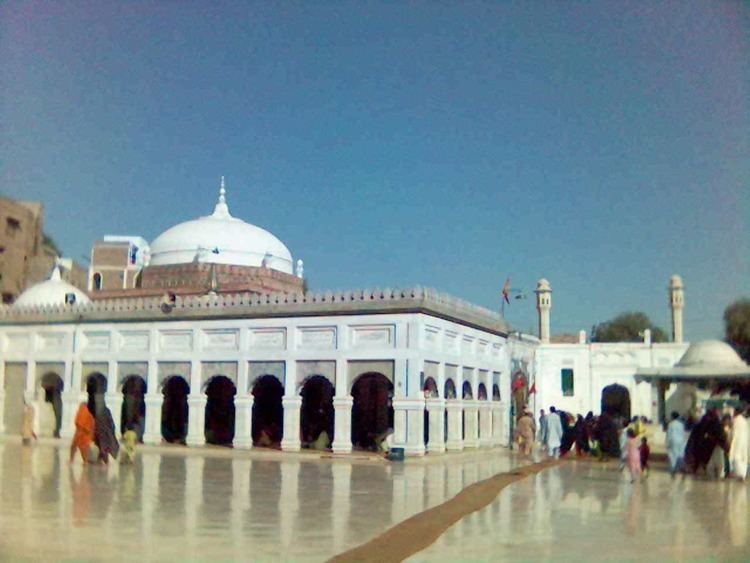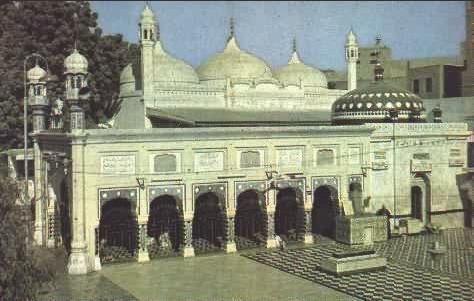Name Fariduddin Ganjshakar | ||
 | ||
Born 1173, Kothewal Parents Maryam Bibi, Jamal-ud-din Suleiman Influenced | ||
Similar Jamal ud Din Hansvi, Alauddin Sabir Kaliyari, Qutbuddin Bakhtiar Kaki | ||
Ziarat e Dargah Hazrat Baba Farid Ganj Shakar(R.A.) Pakpattan, Pakistan
Farīd al-Dīn Masʿūd Ganj-i-Shakar (c. 1175-1266), known reverentially as Bābā Farīd or Shaykh Farīd by Muslims and Sikhs of South Asia, or simply as Farīduddīn Ganjshakar, was an 12th-century Punjabi Muslim preacher and mystic who went on to become "one of the most revered and distinguished ... Muslim mystics" of the medieval period.
Contents
- Ziarat e Dargah Hazrat Baba Farid Ganj ShakarRA Pakpattan Pakistan
- Life
- Poetry
- Legacy
- Shrine
- Baba Farids Serai in Jerusalem
- Chilla
- Death anniversary and Urs
- Mehfil e Sama Qawwali
- Honor in Sikhism
- Places named after
- References

Life

Fariduddin Masud was a great Sufi master who was born in 1179 at a village called Kothewal, 10 km from Multan in the Punjab region of what is now Pakistan, to Jamāl-ud-dīn Suleimān and Maryam Bībī (Qarsum Bībī), daughter of Sheikh Wajīh-ud-dīn Khojendī. He was one of the founding fathers of the Chishti Sufi order. Baba Farid received his early education at Multan, which had become a centre for Muslim education; it was there that he met his teacher Qutbuddin Bakhtiar Kaki, a noted Sufi saint, who was passing through Multan on his way from Baghdad to Delhi. Upon completing his education, Farīd left for Sistan and Kandahar and went to Makkah for the Hajj pilgrimage with his parents at the age of 16.
Once his education was over, he moved to Delhi, where he learned the Islamic doctrine from his master, Qutbuddin Bakhtiar Kaki. He later moved to Hansi, Haryana. When Quṭbuddīn Bakhtiyār Kākī died in 1235, Farīd left Hansi and became his spiritual successor, and he settled in Ajodhan (the present Pakpattan, Pakistan) instead of Delhi. On his way to Ajodhan, while passing through Faridkot, he met the 20-year-old Nizāmuddīn, who went on to become his disciple, and later his successor Sufi khalīfah.

Baba Farid had three wives and eight children (five sons and three daughters). One of his wives, Hazabara, was the daughter of Sulṭān Nasīruddīn Maḥmūd.
The great Arab traveller Ibn Battuta once visited this Sufi saint. Ibn Battuta says that Fariduddin Ganjshakar was the spiritual guide of the King of India, and that the King had given him the village of Ajodhan. He also met Baba Farid's two sons.

Baba Farid's descendants, also known as Fareedi, Fareedies or Faridy, mostly carry the name Fārūqī, and can be found in Pakistan, India and the diaspora. Fariduddin Ganjshakar's descendants include the Sufi saint Salim Chishti, whose daughter was the Emperor Jehangir's foster mother. Their descendants settled in Sheikhupur, Badaun and the remains of a fort they built can still be found. One of his descendants was the noted Sufi scholar Muhibbullah Allahabadi (1587–1648).
Fariduddin Ganjshakar's shrine darbār is located in Pakpattan, Punjab, Pakistan.
Poetry
(The Legend is that when Baba Farid ji went into the jungle to meditate, he took a piece of wood. And he would often chew it whenever he felt hungry as not to get distracted from meditation. In the above verse, he is pointing to the fact that one should follow the path of enlightenment to free oneself from bonds and sufferings).
Fareedudin Gangshakar preached peace and harmony among Muslims, Hindus, and other minorities of South Asia through his poetry. He used to write poetry at peaks of ecstasy, subdued in 'True Love'. The way he describes God's attributes and personality in one of the pieces of his poetry, is transcendental. The piece is called Husn-e-Haqiqi, (The Beauty of Truth).
Husn-e-Haqiqi
O' Beauty of Truth, the Eternal Light!
Do I call you Necessity and Possibility
Do I call you the Ancient Divinity
The One, Creation and the World
Do I call you Free and Pure Being
Or the Apparent Lord of all
Do I call you the Souls, the Egos and the Intellects
The Imbued Manifest, and the Imbued Concealed
The Actual Reality, the Substance
The Word, the Attribute and Dignity
Do I call you Variety and Circumstance
The Demeanor and the Measure
Do I call you the Throne and the Firmament
And the Demurring Delights of Paradise
Do I call you Mineral and Vegetable
Animal and Human
Do I call you the Mosque, the Temple, the Monastery
the Scriptures, the Quran
the Rosary, the Girdle
Godlessness, and Faith
Do I call you the Clouds, the Flash, the Thunder
Lightning and the Downpour
Water and Earth
The Gust and the Inferno
Do I call you Lakshmi and Ram and Lovely Sita
Baldev, Shiv, Nand, and Krishna
Brahma, Vishnu and Ganesh
Mahadev and Bhagvaan
Do I call you the Gita, the Granth and the Ved
Knowledge and the Unknowable
Do I call you Abraham, Eve and Seth
Noah and the Deluge
Abraham the friend, and Moses son of Amran
And Ahmad the Glorious, Darling of every Heart
Do I call you the Witness, the Lord, or Hejaz
The Awakener, Existence and the Zenith
Do I call you Admiration and Prognosis
Nymph, Fairy and the Young Lad
The Tip and the Nip
And the Redness of Betel Leaves
The Tabla and the Tanpura
The Drum, the Notes and the Improvisation
Do I call you Beauty and the Fragrant Flower
Coyness and that Amorous Glance
Do I call you Love and Knowledge
Superstition, Belief and Conjecture
The Beauty of Power, and Conception
Aptitude and Ecstasy
Intoxication and the Intoxicated
Amazement and the Amazed
Submission and Connection
Compliance and Gnosticism
Do I call you the Hyacinth, the Lilly and the Cypress
And the Rebellious Narcissus
The Bereaved Tulip, the Rose Garden and the Orchard
Do I call you the Dagger, the Lance and the Rifle
The Hail, the Bullet, the Spear
The Arrows made of White Poplar, and the Bow
The Arrow-notch, and the Arrowhead
Do I call you Colorless, and Unparalleled
Formless in Every Instant
Glory and Holiness
Most Glorious and most Compassionate
Repent now Farid forever!
For whatever I may say is Less
Do I call you the Pure and the Humane
The Truth without trace or name
This piece of poetry was sang by Arieb Azhar, a Pakistan Sufi singer, in 2010 on platform of Coke Studio Season 2 Episode 5.
Legacy
One of Farīd's most important contributions to Punjabi literature was his development of the language for literary purposes. Whereas Sanskrit, Arabic, Turkish and Persian had historically been considered the languages of the learned and the elite, and used in monastic centres, Punjabi was generally considered a less refined folk language. Although earlier poets had written in a primitive Punjabi, before Farīd there was little in Punjabi literature apart from traditional and anonymous ballads. By using Punjabi as the language of poetry, Farīd laid the basis for a vernacular Punjabi literature that would be developed later.
The city of Faridkot bears his name. According to legend, Farīd stopped by the city, then named Mokhalpūr, and sat in seclusion for forty days near the fort of King Mokhal. The king was said to be so impressed by his presence that he named the city after Baba Farid, which today is known as Tilla Baba Farid. The festival Bābā Sheikh Farād Āgman Purb Melā' is celebrated in September each year from (21–23 Sep, for 3 days), commemorating his arrival in the city. Ajodhan was also renamed as Farīd's 'Pāk Pattan', meaning 'Holy Ferry'; today it is generally called Pāk Pattan Sharīf.
Faridia Islamic University, a religious madrassa in Sahiwal, Punjab, Pakistan, is named after him, and in July 1998, the Punjab Government in India established the Baba Farid University of Health Sciences at Faridkot, the city which itself was named after him.
There are various explanations of why Baba Farid was given the title Shakar Ganj ('Treasure of Sugar'). One legend says his mother used to encourage the young Farīd to pray by placing sugar under his prayer mat. Once, when she forgot, the young Farīd found the sugar anyway, an experience that gave him more spiritual fervour and led to his being given the name.
Shrine
The small Shrine of Baba Farid is made of white marble with two doors, one facing east and called the Nūrī Darwāza or 'Gate of Light', and the second facing north called Bahishtī Darwāza, or 'Gate of Paradise'. There is also a long covered corridor. Inside the tomb are two white marbled graves. One is Baba Farid's, and the other is his elder son's. These graves are always covered by sheets of cloth called Chaddars (the green coloured chaddars are covered with Islamic verses), and flowers that are brought by visitors. The space inside the tomb is limited; not more than ten people can be inside at one time. Ladies are not allowed inside the tomb, but the late Benazir Bhutto, then prime minister of Pakistan, was permitted to enter inside by the shrine guardians, when she visited the shrine. Another rare exceptional case was the late Hajjah Kainz Hussain of Jhelum, wife of the late Haji Manzoor Hussain, who was allowed inside the tomb and was given a Chaddar, which resulted in miraculous improvement in her health.
Charity food called Langar is distributed all day to visitors here and the Auqaf Department, which administers the shrine. The shrine is open all day and night for visitors. The shrine has its own huge electricity generator that is used whenever there is power cut or loadshedding, so the shrine remains bright all night, all year round. There is no separation of male and female areas but a small female area is also available. There is a big new mosque in the shrine. Thousands of people daily visit the shrine for their wishes and unresolvable matters; for this they vow to give to some charity when their wishes or problems are resolved. When their matters are solved they bring charity food for visitors and the poor, and drop money in big money boxes that are kept for this purpose. This money is collected by the Auqaf Department that looks after the shrine.
On 25 October 2010, a bomb exploded outside the gates of the shrine, killing six people. Since then, the shrine surroundings and compound area has been renovated.
Baba Farid's Serai in Jerusalem
In great old holy city of Jerusalem, present-day Palestine, there is a place called [Al-Hindi Serai] (Indian lodge or shrine), where it is claimed Baba Farid lived for many years in the early 13th century, almost 800 years ago. Baba Farid walked into Jerusalem around the year 1200, little more than a decade after the armies of Saladin had forced the Crusaders out of Jerusalem. The place is now a pilgrim lodge for Muslims of South Asia. It is claimed that this building is currently cared for by the 86-year-old caretaker, Muhammad Munir Ansari, in 2014. "No one knows how long Baba Farid stayed in the city. But long after he had returned to the Punjab, where he eventually became head of the Chishti order, Indian Muslims passing through Jerusalem on their way to Mecca wanted to pray where he had prayed, to sleep where he had slept. Slowly, a shrine and pilgrim lodge, the Indian Hospice, formed around the memory of Baba Farid." "Later accounts of his life said that he spent his days sweeping the stone floors around al-Aqsa mosque, or fasting in the silence of a cave inside the city walls."
Chilla
A Chilla of Baba Farid is located in Dhirdan village of Lunkaransar tehsil in Bikaner district, Rajasthan, India.;Maharashtra, Amravati district village Poraha and Wardha district samudrapur constituency in Girad a small town, in shakar baoli and in a small village Manegaon situated in Tehsil Barghat, District Seoni, Madhya Pradesh and in Ajmer dargha sharif.
Death anniversary and Urs
Every year, the saint's death anniversary or Urs is celebrated for six days in the first Islamic month of Muharram, in Pakpattan, Pakistan. The Bahishtī Darwāza (Gate of Paradise) is opened only once a year, during the time of the Urs fair. Hundreds of thousands of pilgrims and visitors from all over the country and the world come to pay homage. The door of the Bahishti Darwaza is made of silver, with floral designs inlaid in gold leaf. This "Gate to Paradise" is padlocked all year, and only opened for ten days from sunset to sunrise in the month of Muharram. Some followers believe that by crossing this door all of one's sins are washed away. During the opening of the Gate of Paradise, extensive security arrangements are made to protect people from stampedes. In 2001, 27 people were crushed to death and 100 were injured in a stampede. The Urs is celebrated every year from the fifth through the tenth of Muharram. Some of his personal belongings were taken by his descendant Sheikh Salim Chishti, and kept in a fort built by his descendants in Sheikhupur, Badaun, where they are preserved in a conatiner called Pitari. To this day it is taken out in a procession for the first six days of Muharram.
Mehfil-e-Sama (Qawwali)
One of the significant features of the daily life of the shrine is Qawwali. It is performed all day at some part of the shrine, but at night it attracts a huge gathering. Every Thursday evening, there is a big Mehfil-e-Sama just outside the tomb, that lasts all night and attracts hundreds of people. Many famous and popular Qawwals (Qawwali singers) of the country participate in the Mehfil. Many listeners become so mesmerised that they start dancing a traditional religious dance called Dhamaal. The first Thursday evening of every lunar month attracts extra thousands of people, making the shrine jam packed.
Honor in Sikhism
Baba Farid, as he is commonly known, has his poetry included in the Guru Granth Sahib, the most sacred scripture of Sikhism, which includes 123 (or 134) hymns composed by Farid. Guru Arjan Dev Ji, the 5th guru of Sikhism, included these hymns himself in the Adi Granth, the predecessor of the Guru Granth Sahib.
The town of Faridkot in Punjab, India is named after him.
